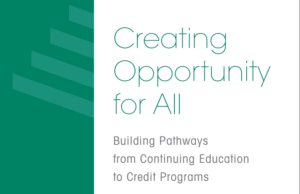One important challenge the Northeast Resiliency Consortium colleges took on was aligning continuing education and credit programs along a career pathway to meet student and labor market needs. This brief describes how the colleges made adjustments to articulate non-credit to credit credentials to ensure strong career pathways for students who start on the non-credit ramp. As a result, the colleges are now providing students with stacked credentials, ensuring prior learning and experience is accounted for within pathways, and are formally recognizing key milestones with credentials. All in all, the colleges smoothed the way for students to work toward an associate degree even if they began their studies in a non-credit program.
The results of this work are promising. As you will learn in this issue brief, according to the Northeast Resiliency Consortium Final Evaluation Report, a higher percentage of students enrolled in continuing education to credit pathways banked or earned credits, transitioned to credit-based programs, and gained and were retained in employment than a matched comparison group who did not enroll in these pathways.
Download the guide
